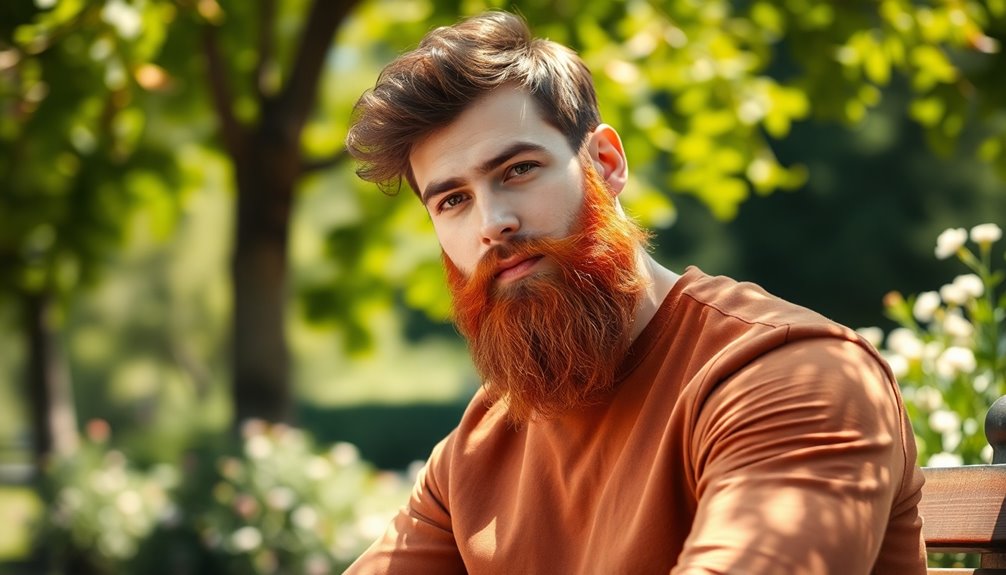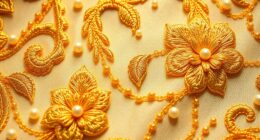If you've spotted someone with brown hair and a vivid red beard, you're witnessing a surprising genetic phenomenon! This eye-catching combo stems from the MC1R gene, responsible for producing different types of melanin in hair. Brown hair often features high eumelanin levels, while red facial hair, courtesy of pheomelanin, can emerge due to unique gene expressions. It's a fascinating reminder of how our genes can mix and match, sometimes skipping generations altogether. With only about 1-2% of the global population rocking this look, it's no wonder such striking traits turn heads. Stick around to uncover more about this intriguing genetic mix!
Key Takeaways
- The MC1R gene influences hair color, leading to brown hair and red beards due to different expression patterns in scalp and facial hair.
- Approximately 1-2% of the global population carries the genetic variant for red hair, resulting in surprising combinations like red beards with brown hair.
- Environmental factors, such as sun exposure and hormonal changes, can reveal unexpected red hues in hair, including facial hair.
- Cultural perceptions of red beards vary, often viewed as symbols of uniqueness, strength, or linked to historical figures like Vikings and Celts.
- Family genetics may reveal distant ancestral traits, leading to the emergence of red beards in individuals with predominantly brown hair.
Understanding Hair Color Genetics
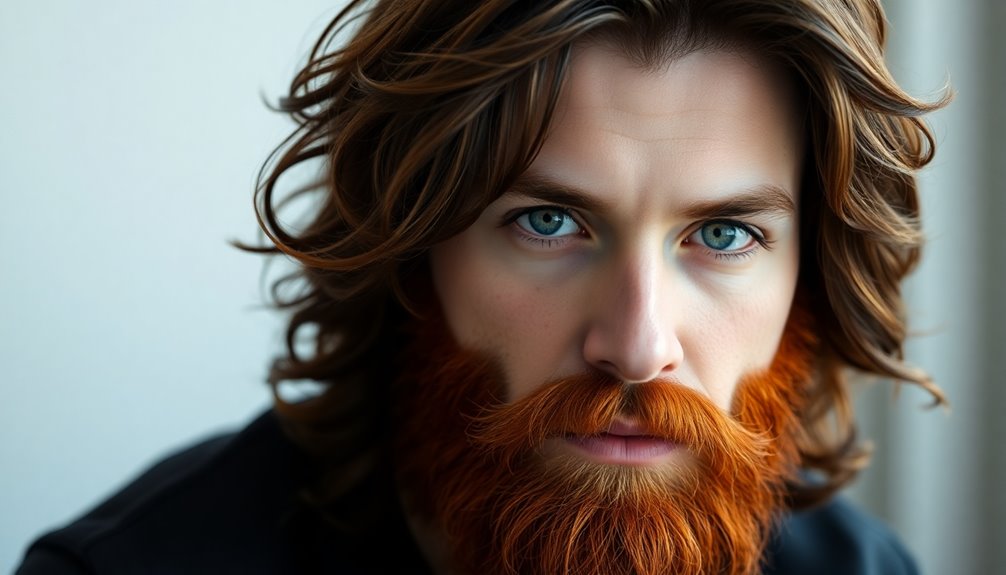
When it comes to hair color genetics, many factors come into play. You might notice a striking contrast between your brown hair and a fiery red beard, and that's where the MC1R gene steps in. This gene is a key player in determining how your body produces pigmentation.
You see, brown hair typically results from higher levels of eumelanin, while red hair is linked to increased pheomelanin production, which can be influenced by variations in the MC1R gene.
Imagine a scenario where your family history reveals unexpected hair color traits; maybe your grandfather had a red beard too! This genetic inheritance can lead to surprising expressions of hair color, making your beard a bold statement, even if your scalp doesn't match.
And let's not forget about environmental factors—things like age and hormonal changes can also affect your hair's pigmentation over time.
The MC1R Gene Explained
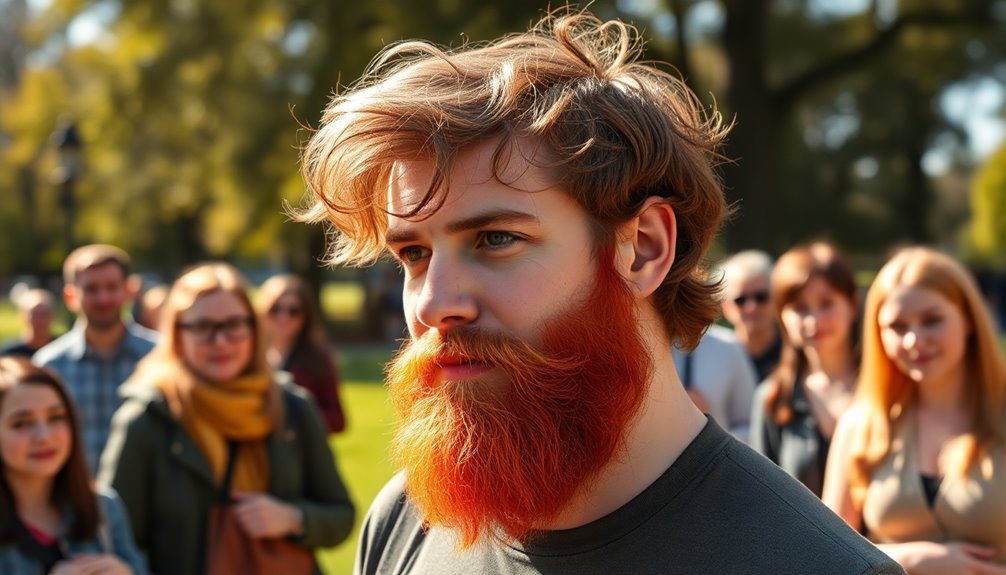
The MC1R gene plays an essential role in determining your hair and skin color by regulating melanin production in hair follicles. Located on chromosome 16, it produces the melanocortin 1 receptor, which is vital for the synthesis of melanin. Variants of the MC1R gene can lead to different outcomes; for instance, some variations produce pheomelanin, resulting in that stunning red pigmentation we often admire.
Isn't it fascinating that you can have a red beard while your scalp hair is a different color? That's the MC1R gene at work, showcasing its differential expression in various hair regions.
While only about 1-2% of the global population carries the variant linked to red hair, many non-redheads can still sport red facial hair, thanks to these quirky genetic combinations.
Understanding the MC1R gene not only sheds light on unexpected beard colors but also reveals broader patterns of human pigmentation and genetic diversity.
Red Beard vs. Brown Hair
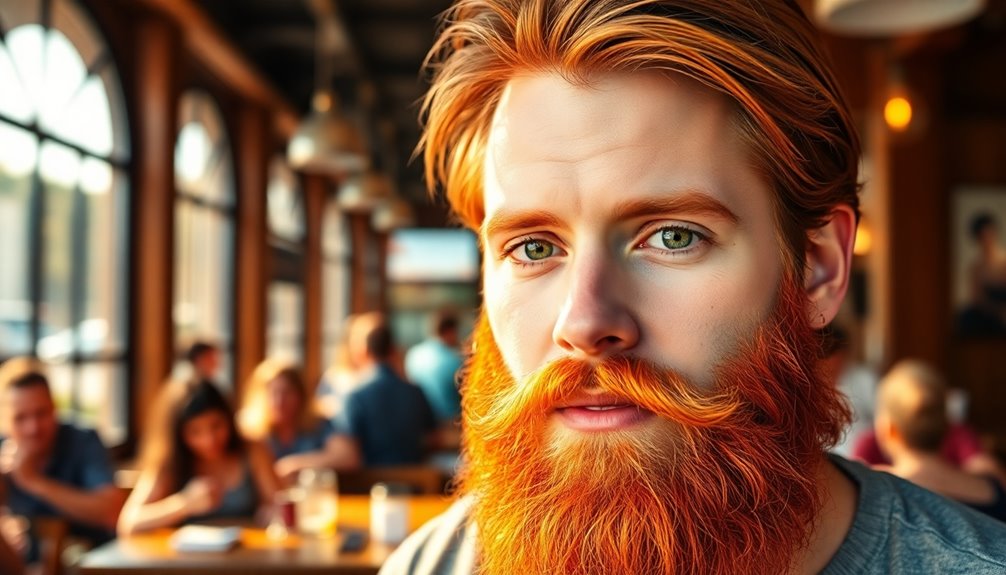
Have you ever noticed how some guys rock a striking red beard alongside their brown hair?
This fascinating contrast often comes down to the MC1R gene, which can reveal hidden ancestral traits and create a unique blend of genetic expression.
It's not just rare; it's a fun reminder of how our genes can play tricks on us, turning expectations upside down!
Genetic Expression Variability
Many people are surprised to find that a red beard can coexist with brown hair, highlighting the fascinating complexities of genetic expression. This unexpected combination stems from how our genes interact, leading to variations in hair color across different parts of the body.
Here are three key points to understand this phenomenon:
- MC1R Gene Variant: A single mutated MC1R gene can cause you to sport a striking red beard while your scalp remains a rich brown.
- Distinct Trait Expression: Genetic inheritance is complex, with multiple genes influencing traits, which means your beard and scalp hair can express different colors.
- Ancestral Genetics: Sometimes, red hair traits can skip generations, making it a surprise when a descendant suddenly showcases a fiery beard.
What's even more intriguing is that environmental factors and aging can affect these colors, so you might find that your red beard becomes more pronounced as you grow older.
This unpredictability in genetic expression not only keeps you guessing but also adds a unique flair to your appearance, making your red beard a remarkable indication of your genetic heritage.
MC1R Gene Influence
Genetic diversity reveals intriguing outcomes, especially when it comes to hair color variations like a red beard paired with brown hair. The MC1R gene, found on chromosome 16, plays a pivotal role in this phenomenon. It's responsible for producing the melanocortin 1 receptor, which determines the type of melanin your hair follicles create.
A mutation in the MC1R gene can lead to brown hair on your head while producing red pigment in your beard, showcasing how this gene can express differently in various hair regions.
If you've got brown hair but rock a red beard, you might've just one functional MC1R gene. This doesn't mean your hair color is set in stone—it means the interaction of the MC1R gene with other genetic factors can surprise you.
It's like a genetic game of hide-and-seek, where traits can skip generations, hinting at your ancestry. So, each time you notice that fiery facial hair, remember: it's a demonstration of the complex mechanics of hair color genetics, where unexpected combinations can turn heads and spark conversations.
Ancestral Traits Revealed
Uncovering ancestral traits can lead to fascinating discoveries, especially when you come across a red beard contrasting with brown hair. This striking combination often points to a unique genetic twist, primarily linked to the MC1R gene.
You might find it surprising how these traits can intermingle across generations. Here are three key insights to reflect upon:
- Genetic Variation: The MC1R gene can express differently in facial hair versus scalp hair, allowing for a red beard even when your head hair is brown.
- Ancestral Influence: If you have red-haired relatives in your family tree, they could be the reason behind your unexpected red beard, even if you lack red hair on your head.
- Surprising Appearances: Genetic expressions can skip generations, meaning you could rock a red beard while your ancestors had none, thanks to isolated color mutations.
This phenomenon is more common than many realize, highlighting how the MC1R mutation produces pheomelanin, the pigment responsible for that eye-catching red.
Ancestry and Hair Color
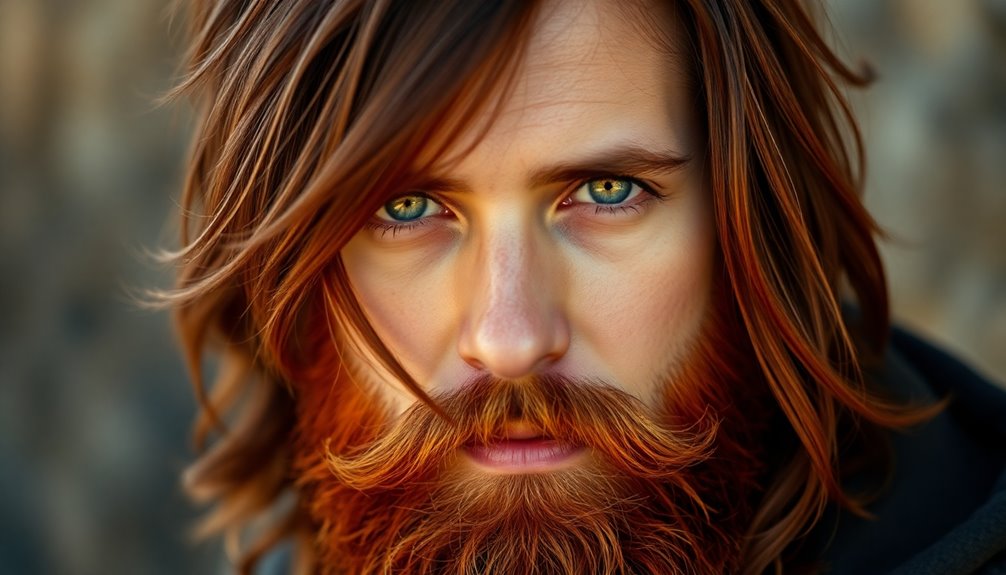
When exploring ancestry and hair color, you might be surprised to find that a seemingly simple trait like a red beard can disclose complex genetic stories. The presence of a red beard in individuals with brown hair often stems from a mutation in the MC1R gene, which affects pigmentation differently across various areas of the body.
This fascinating genetic twist shows how ancestral lineage plays a significant role in hair color expression, revealing traits from distant relatives that might unexpectedly pop up in your own family.
Interestingly, only about 1-2% of the global population has red hair, yet even those without red locks can sport red facial hair due to these underlying genetic factors.
So, if you're scratching your head at that fiery beard on a brown-haired guy, know it's more than just a coincidence; it's a hint of ancestral connections. Genetic variations can disclose hidden traits, making red facial hair a potential marker for red-haired relatives you never knew existed.
Embracing this quirky aspect of your ancestry can be both enlightening and entertaining, reminding us all that our genes carry stories waiting to be discovered.
Cultural Perceptions of Red Beards
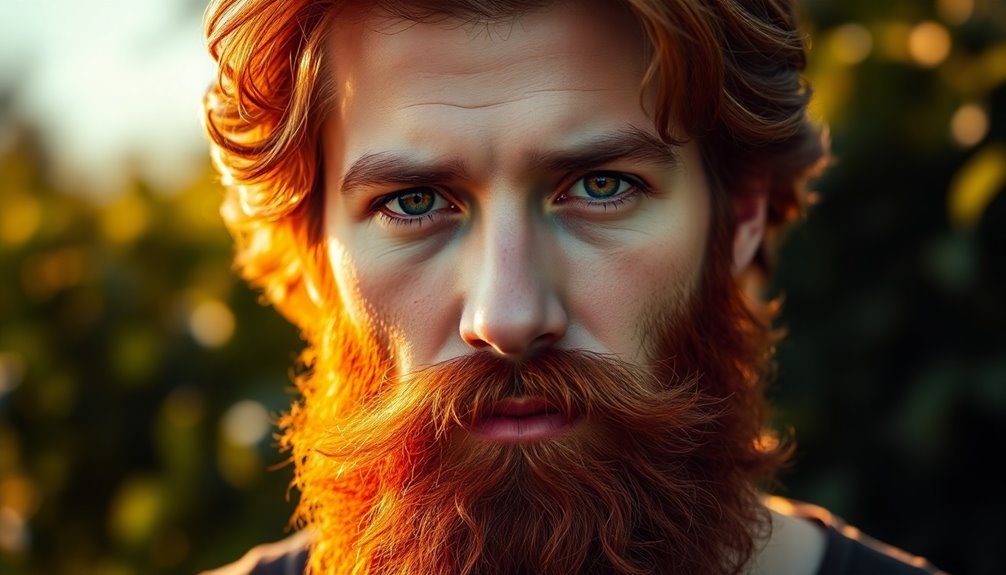
When you think about red beards, they often spark a mix of admiration and stereotypes that can shape how people view masculinity.
In various cultures, a red beard might be celebrated as a badge of individuality or, conversely, tied to outdated perceptions.
You can see this influence in historical figures and pop culture, where the portrayal of these unique beards can either romanticize or vilify their wearers, adding layers to the conversation around identity and grooming.
Unique Cultural Identities
Although red beards may seem like a simple aesthetic detail, they carry significant cultural weight, particularly in regions like Scotland and Ireland, where they symbolize a rich heritage and distinctiveness.
When you encounter someone with a red beard, you might be witnessing more than just a striking appearance; you're seeing a connection to a unique cultural identity.
Here are a few aspects that define this fascinating phenomenon:
- Heritage: Red beards often link individuals to their ancestral roots, reflecting the historical prevalence of red hair in certain regions.
- Community: Those with red beards frequently find camaraderie, sharing experiences that reinforce their unique identity, even among those with brown hair.
- Symbolism: In folklore and mythology, red beards are sometimes linked to fierce independence, painting a picture of strength and non-conformity.
This unique combination of traits not only challenges traditional views on masculinity but also fosters a sense of pride in individuality.
Societal Stereotypes and Attitudes
Perceiving red beards often evokes a mix of fascination and stereotypes that shape societal attitudes across cultures. These striking features, found in only 1-2% of the global population, draw attention and spark conversation. Monsters and mythical beings have often been depicted with unique traits, reflecting the psychological appeal of folklore in various cultures. In some cultures, red beards symbolize masculinity and individuality, representing a unique cultural identity that many admire. You might even find yourself drawn to the allure of red-haired individuals in literature and media, where they've often been portrayed as bold or adventurous.
Additionally, the unique traits associated with red beards can evoke discussions about vibrational alignment in personal identity and self-expression. However, red beards aren't universally celebrated. In certain regions, they face mockery or negative stereotypes, which can create a complex social dynamic.
As society evolves, there's been a noticeable shift towards greater acceptance and celebration of red beards. With the rise of grooming trends and genetic studies shedding light on hair color, these once-controversial traits are now embraced, showcasing the beauty of diversity. Understanding emotional intelligence can also play a role in how individuals perceive and interact with those who have unique features like red beards.
Historical Figures' Influence
Throughout history, red beards have captured the imagination, often linked to powerful figures who've shaped cultural perceptions. You might be surprised to learn that these striking features have been portrayed in various ways, primarily as symbols of strength and uniqueness.
Here are a few historical influences that have contributed to our views on red beards:
- Viking Warriors: Often depicted with fierce red beards, these warriors embodied bravery and adventure, solidifying the color's connection with power.
- Celtic Leaders: Leaders like those from ancient Celtic society were similarly associated with red beards, reinforcing their image as bold and fearless.
- Mythical Figures: Characters like Thor, the Norse god, sported fiery red hair, adding a layer of mystique and legend to the color.
The rarity of red beards, found in only about 1-2% of the global population, further enhances their allure.
Over time, societal views have shifted, with red beards evolving from stereotypes to symbols of diversity and uniqueness.
Factors Influencing Hair Color
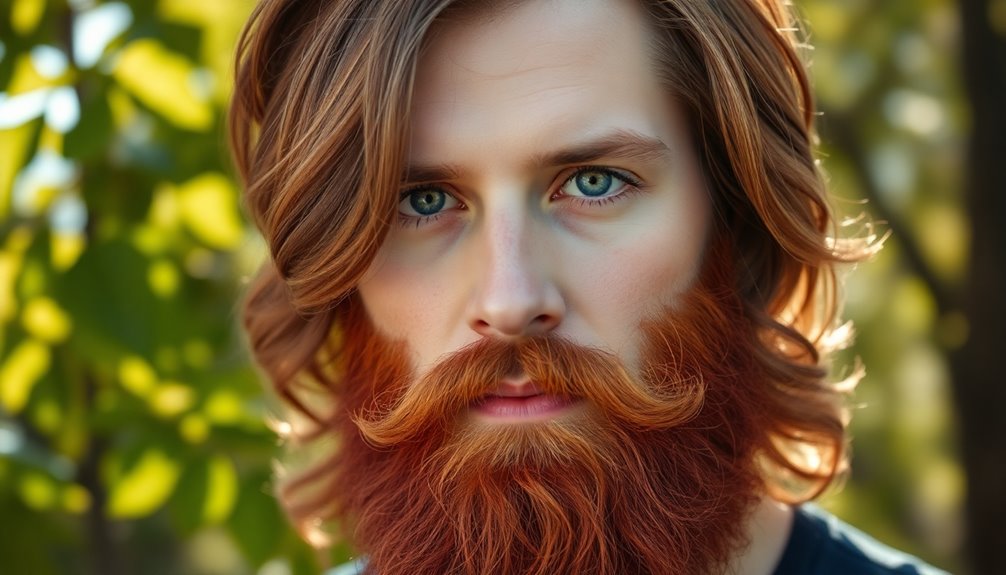
Numerous factors influence hair color, making it a dynamic feature that can change over time.
You might be surprised to learn that age plays a significant role. As you grow older, hormonal changes can lead to variations in your hair color, sometimes resulting in a striking red beard on brown hair.
Sun exposure also deserves a mention; prolonged time outdoors can lighten hair pigmentation, potentially giving you that unexpected red hue.
Your diet is another vital factor. Nutritional elements, like vitamins and minerals, are essential for healthy hair, and deficiencies can lead to alterations in hair color.
Plus, stress isn't just a mental game; it can impact your hair color too. Some studies suggest that increased stress might lead to premature graying or even changes in pigmentation.
The Rarity of Red Beards
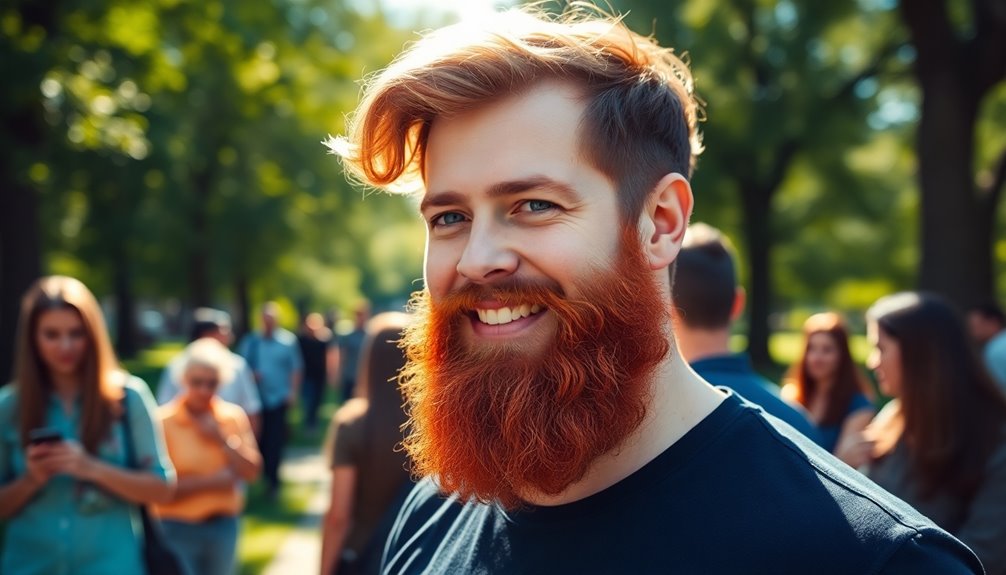
Red beards embody a certain uniqueness that captivates many. These striking facial features are a rarity, appearing in only about 1-2% of the global population.
Imagine the surprise when you find someone with a red beard, especially if their hair color is dark or brown. Here's a quick look at what makes red beards so intriguing:
- Genetic Variants: The MC1R gene plays a vital role, affecting hair pigmentation differently on your scalp than on your face.
- Celtic Heritage: Red beards are particularly common among individuals of Celtic descent, where the traits are more prevalent.
- Cultural Perception: The uniqueness of red beards often leads to them being viewed as symbols of individuality, setting you apart from the crowd.
The unpredictable nature of genetics means you can sport a fiery red beard even if your head hair is a completely different shade.
This delightful quirk adds to the charm and allure of red beards, making them a fascinating topic worthy of attention.
Fun Facts About Hair Color
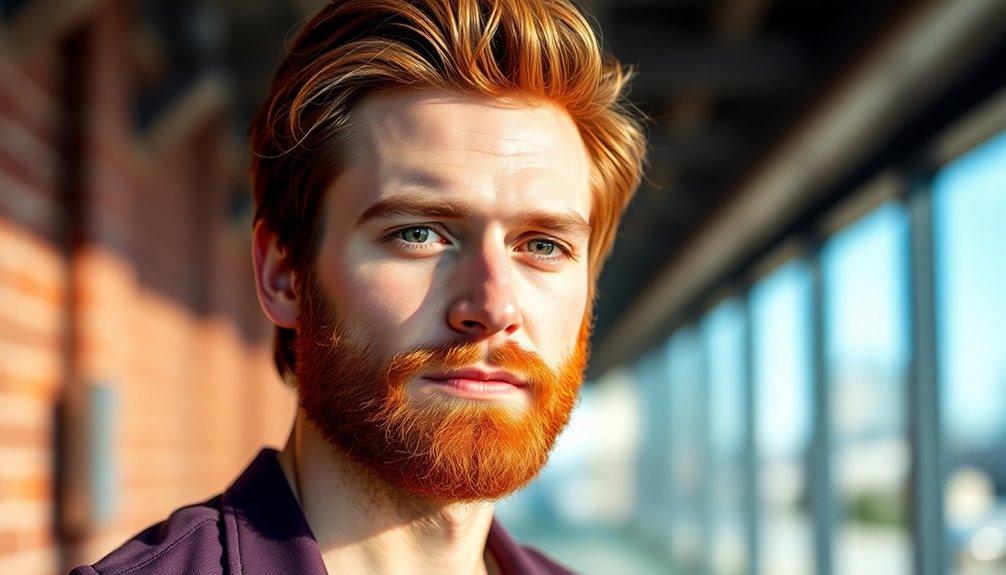
Did you know that only about 1-2% of the global population has red hair? This rarity, often tied to Northern European roots, can lead to fascinating genetic surprises—like seeing someone with brown hair sporting a fiery red beard.
Plus, red hair has a special place in culture, with famous characters like Ron Weasley making it a symbol of uniqueness and charm.
Rarity of Red Beards
Only about 1-2% of the global population has red hair, which makes spotting a red beard even more unusual. When you think about it, red beards are a rare genetic treasure!
Here are a few fun facts to illustrate their uniqueness:
- Genetic Mutation: The MC1R gene is responsible for red hair and beard color, and this mutation can lead to surprising combinations. You might see a man with a dark mane sporting a vibrant red beard!
- Celtic Connection: Red beards are especially common in Celtic countries like Scotland, Ireland, and Wales, adding to their cultural charm.
- Diverse Origins: Believe it or not, red beards can appear on men with various hair colors, including blond and graying hair, making them even more distinctive.
The rarity of red beards doesn't just make them visually striking; it also sparks curiosity and intrigue.
People often associate them with unique stories and attributes. So, the next time you spot a red beard, take a moment to appreciate the genetic miracle behind it—it's not something you see every day!
Cultural Significance of Red
The striking hue of red hair carries a rich cultural significance that extends beyond just its rarity. With only about 1-2% of the global population sporting this vibrant color, you might find yourself feeling special if you have red hair or a red beard.
The prevalence is particularly high among individuals of Northern European descent, especially in Celtic countries like Scotland and Ireland, where red hair is often celebrated as part of their unique cultural identity.
In popular culture, red-haired characters like Merida from "Brave" and Ron Weasley from "Harry Potter" have captured hearts and further emphasized the allure of red locks.
However, red hair and red beards sometimes come with stereotypes, leading to both admiration and misconceptions. This duality adds to the intrigue each time you spot someone with a fiery mane or a striking red beard.
Genetic Surprises Explained
When it comes to hair color, genetic surprises can be both fascinating and unexpected. You might think that hair color is straightforward, but it's anything but! The MC1R gene mutation allows for some intriguing variations, leading to the phenomenon of having a red beard while your scalp hair remains a different color.
Here are a few fun facts to illustrate this:
- Only about 1-2% of the global population has red hair, yet many non-redheads can sport red facial hair thanks to genetic variations.
- Red beards can pop up on men with dark, blonde, or even graying hair, showcasing the complexity of genetic expression.
- The rarity of red hair and beards, especially outside Celtic descents, makes them uniquely engaging and culturally significant.
These genetic variations highlight how our DNA can surprise us in ways we mightn't expect.
Red beards often come with their own set of cultural stereotypes, adding layers to their allure.
Evolutionary Insights on Hair Color
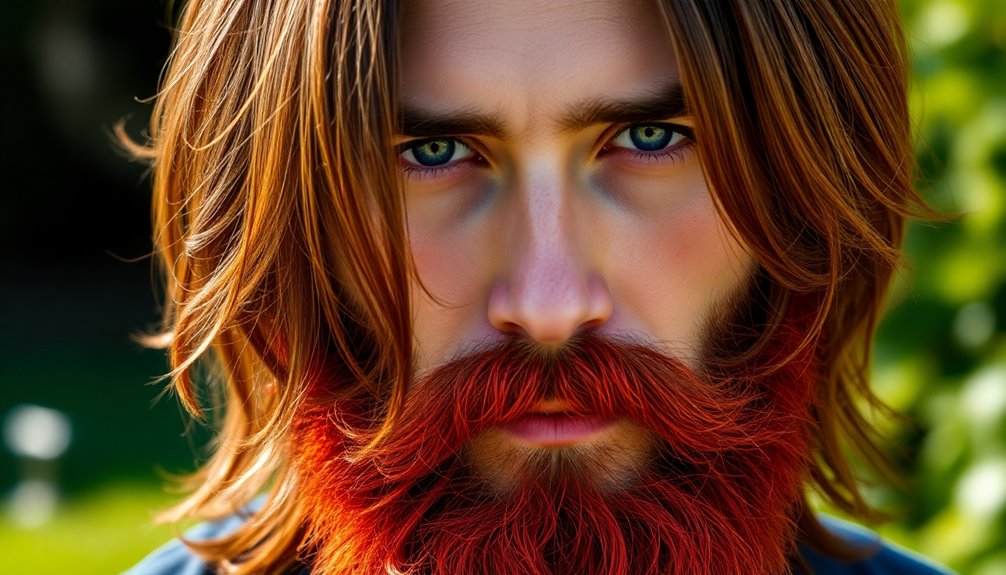
Hair color, particularly the striking contrast of red hair and red beards, offers fascinating insights into human evolution. You might be surprised to learn that red hair results from specific mutations in the MC1R gene, which affects melanin production. This gene can create distinct color variations between your scalp and facial hair, leading to those eye-catching red pigments.
Red hair is rare, affecting only about 1-2% of the global population. It's most common among individuals of Northern European descent, especially in Celtic regions. Evolutionarily, this unique trait might've provided advantages in lower sunlight environments, enhancing vitamin D synthesis, essential for bone health.
When you encounter someone with a brown-haired person sporting a red beard, you're witnessing genetic diversity at play. This unexpected combination can contribute to adaptability, helping people thrive in various conditions.
Plus, the unique traits associated with red hair can influence social dynamics and mate selection. After all, who wouldn't find a vibrant red beard intriguing? In many cultures, these distinctive features capture attention and spark curiosity, reminding us of the intricate connection between genetics and evolution.
Exploring Family Genetics
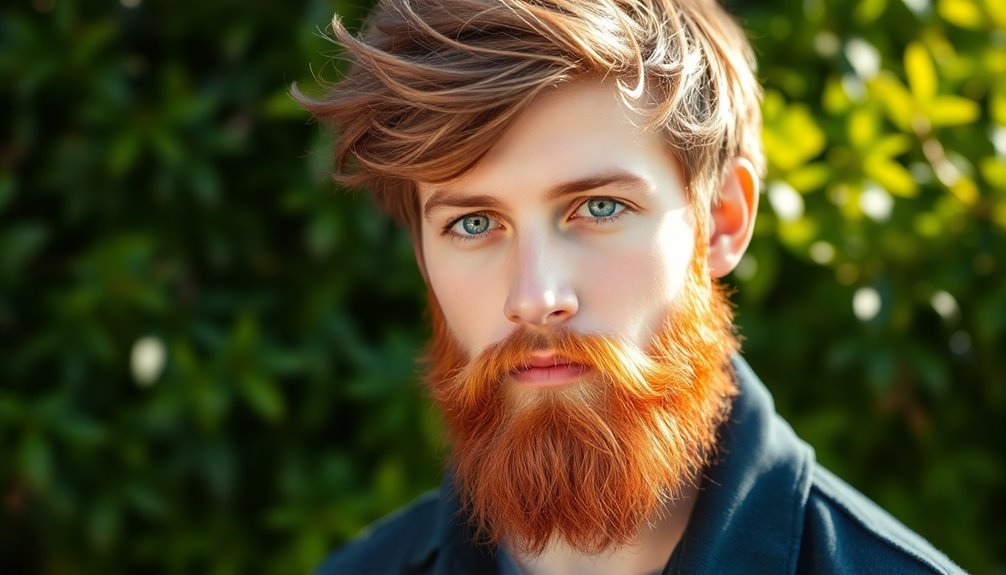
Genetic traits often weave through family lines in unexpected ways, disclosing a rich tapestry of inheritance. When you notice a brown-haired individual sporting a striking red beard, it's a delightful reminder of how genetics can surprise us. This phenomenon often ties back to the MC1R gene, which can lead to distinct hair color expressions.
Here are three ways family genetics might play a role:
- Ancestors Matter: Distant relatives may carry genes that resurface in unexpected ways, like a red beard sprouting from a mainly brown-haired lineage.
- Complex Inheritance: Variations in genetics can lead to a red beard while maintaining a different scalp color, showcasing the intricate dance of heredity.
- Hidden Traits: Understanding your family's genetic history can disclose surprises, revealing how traits like a red beard can emerge even if they seem out of place.
These genetic quirks remind us of the deeper connections we share with our family trees.
Frequently Asked Questions
Why Is My Brown Beard Turning Red?
If your brown beard is turning red, it could be due to a mix of genetics and environmental factors.
Your MC1R gene influences hair pigmentation, and changes in hormones or age might bring out those hidden red tones.
Sun exposure can also lighten your beard, revealing underlying colors.
Plus, if your ancestors had red hair, you're more likely to inherit this quirky trait.
Embrace it; it adds character to your look!
What Is the Genetic Mutation of Red Beard Brown Hair?
You might be surprised to learn that the genetic mutation linked to your red beard while sporting brown hair lies in the MC1R gene.
This little troublemaker affects melanin production, allowing pheomelanin, the pigment that gives red hair its hue, to shine through in your beard.
So, while your scalp hair sticks to its darker roots, your facial hair's flaunting its vibrant side.
Genetics can be quirky, but that's what makes you unique!
Why Is My Boyfriend's Beard Turning Ginger?
Picture a chameleon changing colors; your boyfriend's beard might be doing something similar! As he ages or experiences hormonal shifts, his once-dark beard can reveal that hidden ginger hue.
This transformation often stems from genetic traits and environmental factors, like sun exposure. It’s fascinating how a mutation in the MC1R gene can lead to this surprising shift, turning his beard into a vibrant reflection of his ancestry. Moreover, the way these genetic characteristics manifest can vary greatly among individuals, showcasing the beautiful diversity of human appearance. For those who appreciate their unique look, knowing how to trim a long beard can be essential for maintaining its style while still celebrating those ancestral traits. With the right techniques, one can balance grooming with the rich history that their beard represents.
What Is the Red Beard Theory?
The red beard theory explains why some folks have red facial hair while their scalp hair is a different color, like brown.
This quirky phenomenon stems from a mutation in the MC1R gene, which affects melanin production.
You might find it fascinating that even non-redheads can sport a ginger beard due to this genetic variation.
It's a beautiful reminder of the complexities of genetics and how unique traits can emerge in unexpected ways!
Conclusion
To sum up, the genetic interplay behind brown hair and red beards is an enthralling topic that highlights our diverse ancestry. Did you know that only about 1-2% of the global population has red hair? This rarity makes red beards even more exceptional! So, whether you're rocking a fiery beard or simply appreciating its uniqueness, remember that genetics is a fascinating tapestry weaving together our histories. Embrace the quirks—after all, they're what make us stand out!
